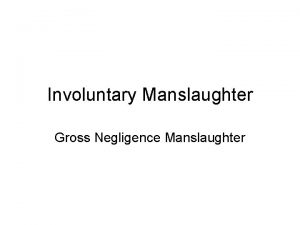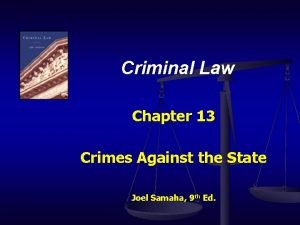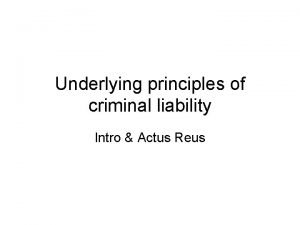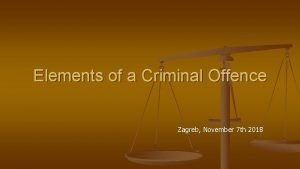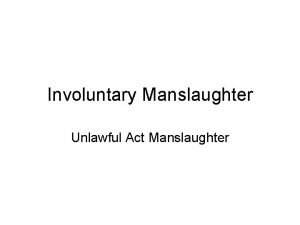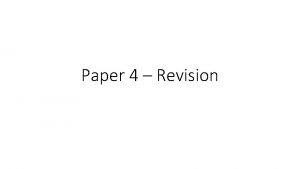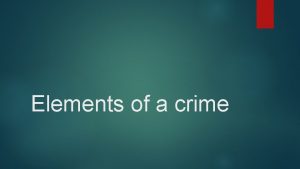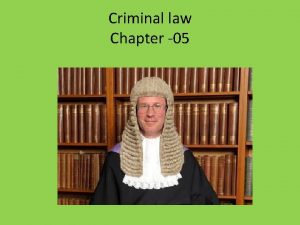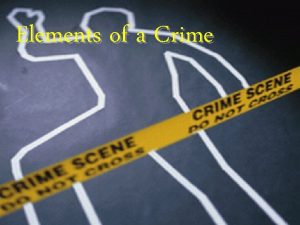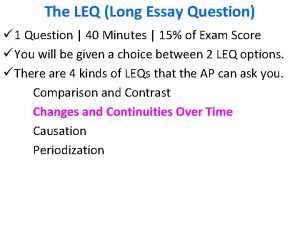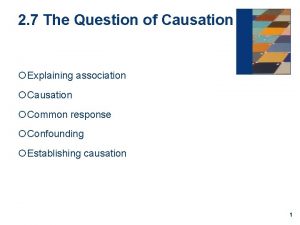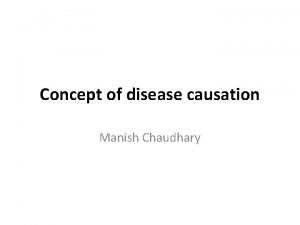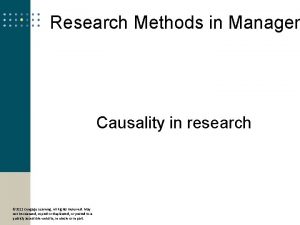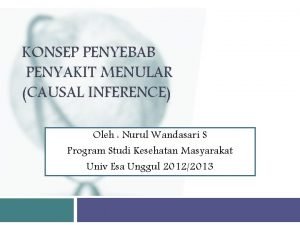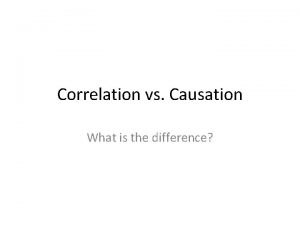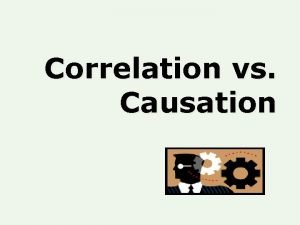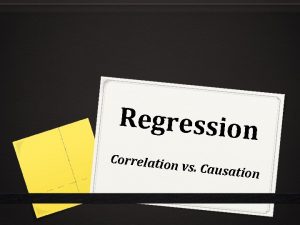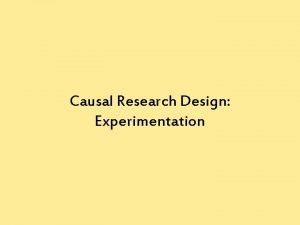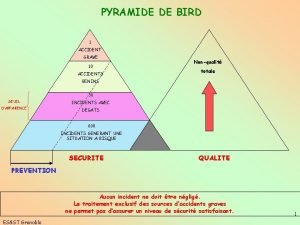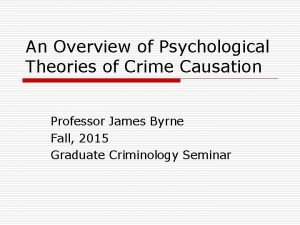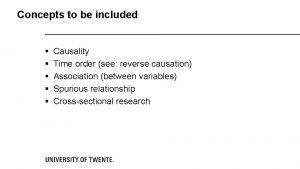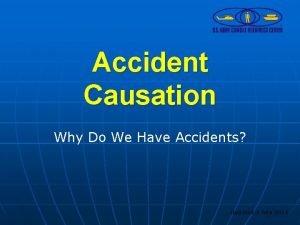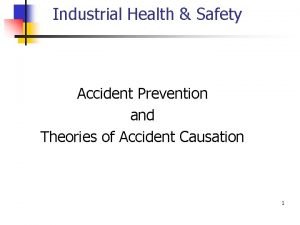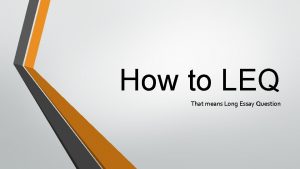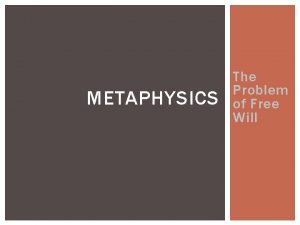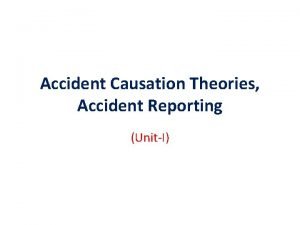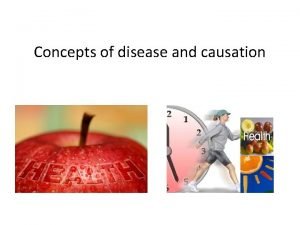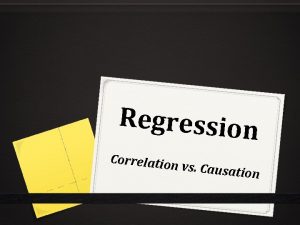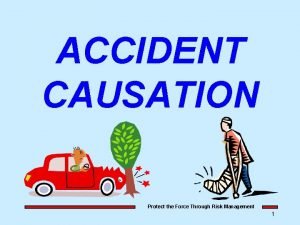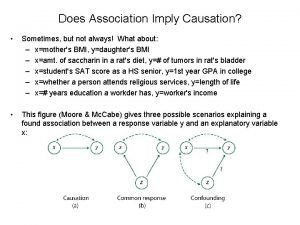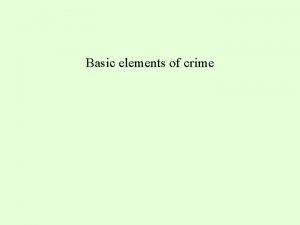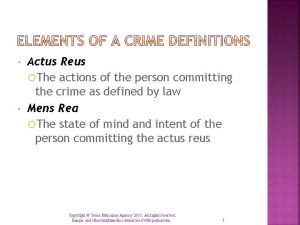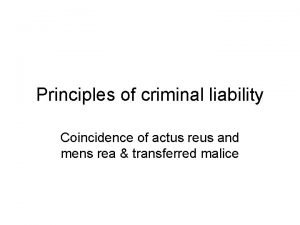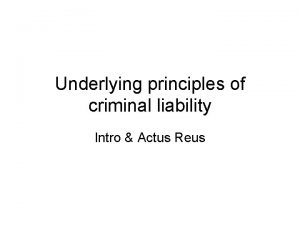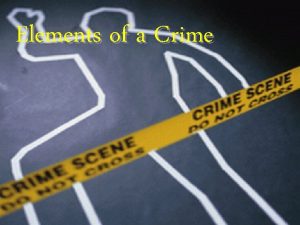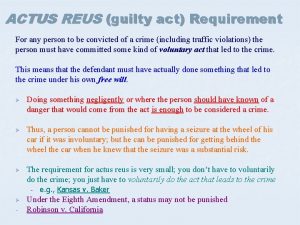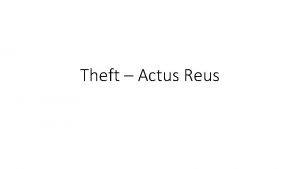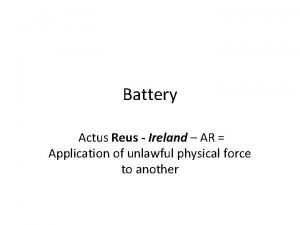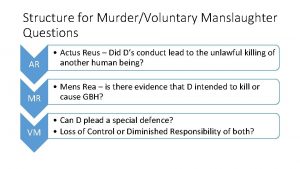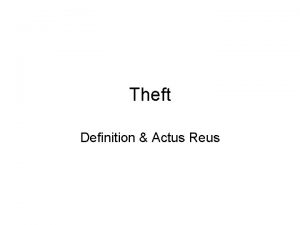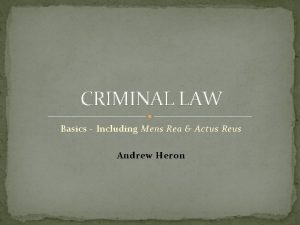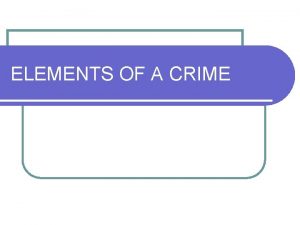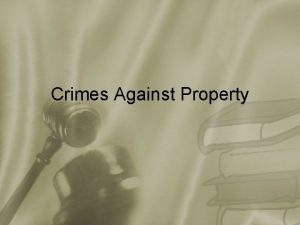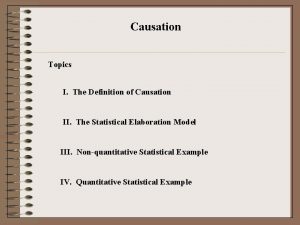CAUSATION The Ds actus reus must have caused


















































- Slides: 50

CAUSATION • The D’s actus reus must have “caused” the harmful result. • The prosecutor must make 2 distinct showings of causation. • 1. That the act was the “cause in fact” of the harm; and • 2. That the act was the “proximate” or “legal” cause of the harm. Covers unintended victim or the intervening act

CAUSE IN FACT • For an act to be a “cause in fact” of a result, it is often said that it must be the “but for” antecedent of that result. • Meaning that if the result would have happened anyway even if the act had not occurred, the act is not a cause in fact of that result. • D shoots V but only grazes him then X comes along and shoots V thru the heart. D’s act is not the “cause in fact” of V’s death since V would have died, and in just the manner he did even if D had not shot him.

CAUSE IN FACT • Expansive test- this make “but for” very expansive as every result will have literally thousands of antecedent “but for” causes in fact. • Follow the domino effect… If …. .

CAUSE IN FACT • “Substantial factor” test-such a cause occurs where an act other than that of the D would have been sufficient to bring about the result, but the D’s act is a “substantial factor” in bringing about the result nonetheless. • D shoots V in the leg causing him to bleed a lot. X then shoots V in the arm V dies from loss of blood from the 2 wounds. Medical evidence shows that V would have died from X’s wound even without D’s wound. However, even though D not “but for” cause his act was a “substantial factor” and thus he is charged with V’s death

Shortening of Life • In determining whether the D’s act is a “substantial factor” in bringing about death, one obviously relevant fact is whether the act shortened the victim’s life. • Who is at fault in the following example: • V is shot by X and will definitely die within a day. If D comes along a shoots V killing him instantly who shortened V’s life?

Lengthening of life • Okay how about this one… • Suppose V is scheduled to take a plane trip, but is poisoned by D, and dies a week later. If the plane crashed killing all aboard, V will have lived almost an extra week. • Is D the cause in fact of V’s death?

Murder Victim must have been alive at the time of act • One more to think about. • D, driving his car, hits V a pedestrian. D flees the scene of the accident, dragging V with him under the car. D is charged with manslaughter, on theory that he was criminally negligent in continuing to drive after the impact. The medical evidence is inconclusive as to whether V was killed upon impact or only after he had been dragged. • And the answer is?

Murder Victim must have been alive at the time of act • Held D cannot be convicted because it has not been shown beyond a reasonable doubt that V was still alive at the time of D’s negligent conduct. ( the driving after the accident). There is nothing that says D was negligent in the first instance of hitting V.

Two People Working Together • If the two occurred as part of a joint enterprise. X and D each shoot V as part of a conspiracy to kill him. the act of each will be attributed to the other and there will be no need to determine whether each wound was a substantial factor in killing V.

Proximate Cause • Once established that the D’s act was a cause in fact of the harm then the prosecution must demonstrate that the act and the harm are sufficiently closely related that the act is the “proximate” or legal cause of that harm. • “Not too remote or accidental in its occurrence to have a bearing on the actor’s liability or on the gravity of the situation. ” • Is more then one proximate cause is possible?

Proximate Cause • Yes… • For instance if X and Y both shoot V so that either wound would have been fatal, and he in fact dies from the combined effect of both wounds, both X and Y will be held to be the proximate causes of V’s death.

Proximate Cause • Year and a day rule in homicide cases. • We cannot convict someone of homicide if the victim did not die until “a year and a day” following the D’s act.

Proximate Cause • Proximate cause issues fall into 2 general categories. • 1. Those in which the type of harm intended occurred and in roughly the manner intended, but the victim was not the intended one. And • 2. The harm occurred and occurred to the intended victim, but in an unintended manner.

Proximate Cause • Unintended Victims generally: • The doctrine of “transferred intent” The D’s intent is “transferred” from the actual to the intended victim. • D intending to kill X, shoots at him, but because of his bad aim, hits and kills V. D is guilty of the murder of V, because his intent is said to be transferred from X to V.

Proximate Cause • This unintended victim rule only applies where the particular result is an element of the crime: • D tries to shoot X to death and merely wounds V, rather then killing him. D may be convicted of battery against V and D may also be convicted of the attempted murder of X. But he may not be convicted of the attempted murder of V.

Proximate Cause • If the resulting crime is more serious the doctrine of transferred intent applies but only enough to make the defendant guilty of the lesser (intended) crime. • D swings his fist at A, intending only to hurt A without causing him serious bodily harm. The punch misses A and hits B in the jaw. B falls down strikes his head on the curb and dies. • What if anything is D guilty of?

Proximate Cause • D is liable only for manslaughter, not murder, because D’s intent is “transferred” to the limited extent of making him guilty for hurting B even though he intended to hurt A; however, he is not liable for the “excess” damage caused to B over what he intended to inflict on A.

Proximate Cause • Higher degree because of victim’s special identity: • D shoots at A, a civilian, intending to kill him. The bullet accidently hits B, a police officer. A statute imposes higher penalties on killing a police officer than killing a civilian. D may probably be convicted of killing a police officer, with the higher penalties.

Proximate Cause • Unintended victim rule also applies to different property destruction. • Suppose D tries to burn down X’s house, but instead the fire spreads or veers due to a change in wind, and burns down V’s house. • D is guilty of arson as to V’s house. • But what if the fire also kills Y will D be guilty of Y’s murder?

Proximate Cause • Actual victim is not foreseeable: • The unintended victim rule probably applies even where the danger to the actual victim was completely unforeseeable.

PROXIMATE CAUSE • For example D shoots at X, the two are out in the desert and think they are alone, but V is sleeping behind some sagebrush when he is hit by the errant bullet. D may nonetheless probably be convicted of murdering V.

PROXIMATE CAUSE • Must be linked to “manner of harm” problems • Suppose that D shoots at X and misses and that X reacts by tracking D down and two days later shooting at him and hitting V by mistake. X might be guilty of murdering V under the unintended victim rule but D will not since X’s act was a superseding cause and too remote to link D to X’ death.

PROXIMATE CAUSE • Must be linked with concurrence rules. • D trying to kill X shoots at him. The bullet misses and instead ruptures a gas line in V’s house causing the house to burn down. Had the bullet killed V, D would have been guilty of murder. But, he will not be guilty of arson of V’s house, since he did not have the mens rea (intent to burn) required of arson.

PROXIMATE CAUSE • Defense assertable against intended victim: • For instance if D shoots at X out of legitimate self-defense , this will prevent him from being guilty of the murder of V if the bullet strikes the wrong target (assuming that D has acted reasonably, which might not be the case if transaction took place on a crowded street. )

PROXIMATE CAUSE • Mistake of identity • If D shoots at V mistakenly thinking that V is really X (D’s enemy). D will be guilty of the murder of V just as if he had been shooting at the person who was actually X and mistakenly hit V.

PROXIMATE CAUSE • Crimes of recklessness or negligence a tighter link is required. • Recklessness D would not be liable for harm to a victim as to whom there was not a high risk of harm foreseeable from the D’s position.

PROXIMATE CAUSE • D decides to take target practice with his rifle in his backyard. He is aware that there is a substantial risk that he will hit someone in his next door neighbor’s house but he shoots anyway. Unbeknownst to him, the neighbor has been storing explosives in the house, the bullet hits the explosives an explosion occurs which starts a fire and the fire kills V who lives a block away and to whom D’s shooting did not impose a foreseeably high risk of harm D will not be liable for recklessness-manslaughter.

PROXIMATE CAUSE • Negligence: The D would probably not be liable for an injury to a victim who was not in the forseeable zone of danger. There would not be transferred negligence.

PROXIMATE CAUSE • Unintended manner of harm generally: does the unexpectedness of the way the harm occurs absolve the D of liability on theory that his act was not the proximate cause of the result. Hmm lets find….

PROXIMATE CAUSE • No liability for bizarre results. • Suppose D gets into a street fight with V, as a result V is knocked unconscious, recovers a few minutes later drives away and gets into an accident which would not have occurred if D had not punched him (since why? ) Thus, the harm to V from the accident was simply too fortuitous a result of D’s battery to make D liable.

PROXIMATE CAUSE • Direct Causation: • Small differences in type of injury: D shoots V trying to hit him in the knee caps and cripple him instead he hits him in the eye blinding him. D is still guilty of mayhem ( the intentional causing of grievous bodily harm) even though the precise type of harm intended did not occur.

PROXIMATE CAUSE • Slightly different mechanism of way then intended D still guilty: • D attempts to poison her husband V by putting rat poison into his glass of “milk”. He drinks it and becomes dizzy from its effect that he falls while getting up from the chair hitting his head on the table. He dies and the evidence shows he may have died from the blow to his head rather then the poison. Nonetheless D is guilty of murder since she created the condition which made the normal act of standing up dangerous and the death is a direct result of her act.

PROXIMATE CAUSE • Pre-existing weakness- must “Take his victim as he finds him” • D beats V up with intent to kill him. V runs away before he is hit too many times and a person of ordinary health would not have been severely hurt by D’s blows. However V is a hemophiliac who bleeds to death from one slight wound. D is guilty of murder even though from D’s viewpoint V’s death from the slight wounds were unforeseeable. (However always remember concurrence)

PROXIMATE CAUSE • Death caused without physical impact from fright or stress D’s conduct can still be the proximate cause of the death. • The Ds hold up V’s business. They require V to lie down on the floor while the money is taken. V, who is an obese 60 year old man with a history of heart disease is very frightened and has a heart attack 15 minutes after the robbery. The heart attack is fatal and the Ds are prosecuted for his death under…. (what rule? )

PROXIMATE CAUSE • Danger to third persons: • One court has even said that D can be liable for the death through fright of V even if he was harming another. • D hits V’s son-in-law in front of V she is so frightened she has a fatal heart attack. D was guilty of misdemeanor manslaughter.

PROXIMATE CAUSE • “Come to rest in apparent safety: ” D’s liability may be limited if even though he was the direct cause of the dangerous force if the V came to rest in a position of apparent safety

PROXIMATE CAUSE • D forces his wife V out of the house at night in freezing weather. She walks to the nearby house of her father without ill consequences, where she would have been taken in at any hour. Not wanting to disturb him in the middle of the night, however, she lies down outside and freezes to death. D is not guilty of manslaughter V had reached a position of apparent safety.

PROXIMATE CAUSE • Intervening Act or event contributes to the result then D has a chance of escaping liability. • Dependent v Independent intervening acts

PROXIMATE CAUSE • Dependent Acts: Those acts and events that would not have occurred except for the D’s act. Intervening cause is superseding. • Independent acts and events that would have occurred even if the D not acted but which combined with the D’s act to produce a harmful result. Intervening cause is unforeseeable.

PROXIMATE CAUSE Example: D beats up V and leaves him by the side of the road. An ambulance picks V up and while rushing to the hospital gets into an accident killing V. D probably liable why? On the other hand if V got up got onto a bus to visit his girlfriend and the bus got into an accident D probably not liable why?

Proximate Cause • • • Four Kinds of Acts Intervening Acts by: 1. Third Persons 2. The Victim 3. The Defendant 4. Non-Human

PROXIMATE CAUSE • Intervening acts by third person: If an intervening act is committed by someone who is neither the V nor the D, that act will generally be superseding only if: 1. it was independent of the D’s act (coincidental) and unforeseeable; or 2. it was dependent on the D’s act (a response to it ) and was abnormal(not merely unforeseeable). • Most common such intervening act is medical treatment.

PROXIMATE CAUSE • Negligent Treatment does not generally by itself be so abnormal to make it a superseding event. Unless the treatment is proven to be reckless or grossly negligent • D shoots V. V then undergoes an operation after and because of the shooting. V dies during the operation because she is not given sufficient blood transfusions. D still guilty.

PROXIMATE CAUSE • Departure from required surgery absolves D • Disease or infection caught in hospital is it directly related to the wounds being treated or was it merely a coincidental by-product of the victim’s presence in the hospital.

PROXIMATE CAUSE • Nonmedical harm same distinction between dependent and independent causes: • The Ds meet V in a bar and decide to rob him. The encourage V to get drunk put him in their car and take his money, his boots and his glasses. They put him on an unlit road on a cold and windy night. Half an hour later as V is sitting in the middle of the road he is run over by X who is driving 10 miles over the speed limit; V dies from his injuries. The Ds are tried for…

PROXIMATE CAUSE • Intended result never superseded if the intervening act leads to a result that is not only of the same general type but is almost identical to the desired result in its manner of occurrence, the intervening act will not be a superseding one. • D intends to kill her 9 month old son gives a bottle of poison to the boy’s nurse saying it’s his medicine. Nurse decides he doesn’t need the “medicine and puts it on a shelf. Several days later the nurse’s 5 yr old son gives the poison to the baby killing him. D is guilty of ….

PROXIMATE CAUSE • Act by Victim: sometimes the victim may take actions which are potentially superseding intervening causes. • 1. Suicide • 2. Victim prefers life to death • 3. Encouraging suicide • 4. Victim refuses medical aid • 5. Victim attempts to avoid danger • 6. Victim subjects himself to danger-Russian roulette, drag racing

PROXIMATE CAUSE • Act by defendant: • Mistake as to death- D intends to kill the victim erroneously believes he has done so and then destroys or conceals the corpse in a way that actually causes death • Is this superseding?

PROXIMATE CAUSE • Recklessness or negligence crime: • D lives with her lover and her 20 month old baby. The lover frequently beats the baby and ultimately kills the baby. Is D guilty of a crime?

PROXIMATE CAUSE • Strict liability crimes: there is no liability unless the actual result is a “probable consequence” of his conduct • A statute makes it a crime to ship drugs not properly labeled. D a pharmacist receives improperly labeled drugs and puts the aside in his drawer to relabel them. That night a theif breaks in steals the drugs and sells them thru the mail. Is D guilty?
 Gross negligence manslaughter actus reus
Gross negligence manslaughter actus reus Elements of treason
Elements of treason Actus reus and mens rea
Actus reus and mens rea Actus reus and mens rea
Actus reus and mens rea Actus reus and mens rea
Actus reus and mens rea Involuntary manslaughter example
Involuntary manslaughter example Actus reus of theft
Actus reus of theft Battery mens rea
Battery mens rea Wheel model of disease causation
Wheel model of disease causation Proximate causation biology example
Proximate causation biology example Proximate behaviour in animals
Proximate behaviour in animals Lee ann de reus
Lee ann de reus Actis reus
Actis reus Human act
Human act What is mens rea
What is mens rea Actus rea
Actus rea Actus rea
Actus rea 6 faces 8 vertices 12 edges
6 faces 8 vertices 12 edges He must become more i must become less
He must become more i must become less World history
World history Causation in criminal law
Causation in criminal law Question 40
Question 40 Association and causation
Association and causation Causation of disease
Causation of disease Reverse causation examples
Reverse causation examples Contoh web of causation
Contoh web of causation Contoh triadic reciprocal causation
Contoh triadic reciprocal causation Example of recall bias
Example of recall bias Statistics correlation vs causation
Statistics correlation vs causation Correlation mistaken for causation
Correlation mistaken for causation Causation vs correlation worksheet
Causation vs correlation worksheet Ap world leq
Ap world leq Example of causal research
Example of causal research Suseptibel
Suseptibel Pyramide de bird
Pyramide de bird Causation with a human face
Causation with a human face Psychological theories of crime
Psychological theories of crime Reverse causality
Reverse causality The army accident causation model
The army accident causation model Ergonomic traps
Ergonomic traps Kinesis ecology
Kinesis ecology The leq
The leq Agent causation
Agent causation Define core-periphery ap human geography
Define core-periphery ap human geography Heinrich triangle theory
Heinrich triangle theory Model of disease causation
Model of disease causation Correlation vs causation
Correlation vs causation The army accident causation model
The army accident causation model Association and causation
Association and causation Các châu lục và đại dương trên thế giới
Các châu lục và đại dương trên thế giới Tư thế worms-breton
Tư thế worms-breton
